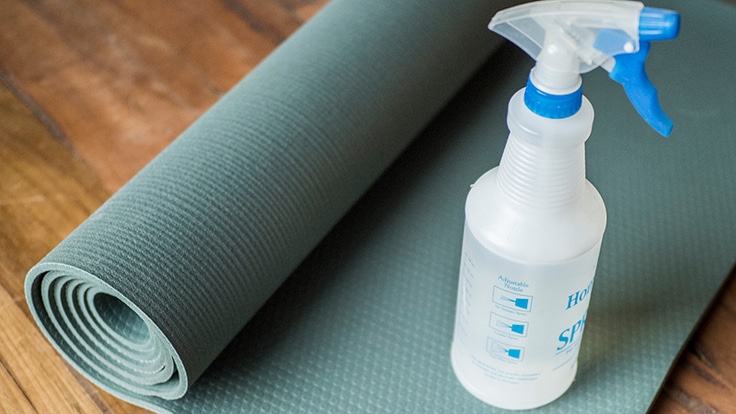Cleaning your yoga mat regularly can help remove dirt, germs and grime, and reduce odors caused by bacteria and sweat that can build up in the mat's materials. This is especially necessary at a gym or studio, where you might share mats with others. But cleaning your mat is also important if you frequently work out at home.
You can buy yoga mat cleaners, but it's easy and affordable to mix your own with products you likely already have around the house.
The following do-it-yourself cleaner recipe includes vinegar and essential oils (optional). Be sure to check your yoga mat's care instructions before cleaning it with either ingredients. Vinegar is not suitable for some mats, like certain ones from Manduka; others may become slippery if you use too much essential oil in your cleaning mix.
What you'll need:
- A spray bottle
White vinegar or witch hazel
- Water
- Optional: Essential oils (our favorites are tea tree, lavender and lemongrass)
Directions:
- Mix vinegar or witch hazel with water at a 1-to-4 ratio in your spray bottle. This means you'll need 1 cup of vinegar for every 4 cups of water.
- If you'd like your spray to be lightly scented, add 2 to 4 drops of essential oil into the bottle. Consider tea tree oil, which has been shown to have some antimicrobial properties. Other popular options include scented oils like lavender, lemongrass, peppermint or orange.
- Cap your bottle, then shake lightly to combine.
- Lay your mat out on a flat surface and spray all over with the cleaning mixture. Spray more cleaner onto your mat than you think you'll need, as it's likely to soak into the material.
- Using a clean towel, rub the cleaner into the mat in circular motions.
- Allow your mat to dry unfurled, then flip it over to clean the other side in the same manner.
- If possible, leave your mat to hang dry over the back of a chair or a porch railing for 12 hours.
- Once your mat is dry to the touch, roll it up tightly and store until needed.
If you use your yoga mat often, consider using your DIY mat cleaner after each practice. You may also want to give your mat a deeper clean every month. One study showed that while a DIY cleaner (made with distilled water, willow bark extract, tea tree oil and lemongrass oil) wasn't effective against major bacteria, it did offer some antibacterial activity at high concentrations.
Note: The Environmental Protection Agency (EPA) does not consider vinegar a registered disinfectant. To kill germs on surfaces, the CDC recommends using a registered disinfectant or, if suitable for the surface, a diluted bleach product. Vinegar is generally considered to be an alternative ingredient for a household cleaner (but not a disinfectant).
Related Articles
Article by Jenni Gritters. Jenni is a Seattle-based freelance journalist. You can find her bylines in the Guardian, Wirecutter, Outside magazine, 538, mindbodygreen and more. When Jenni isn't working with words, she's likely teaching yoga and mindfulness; hiking, camping and snowshoeing in the Pacific Northwest mountains; or running with her husband and puppy. She's been an REI member since 2017.
